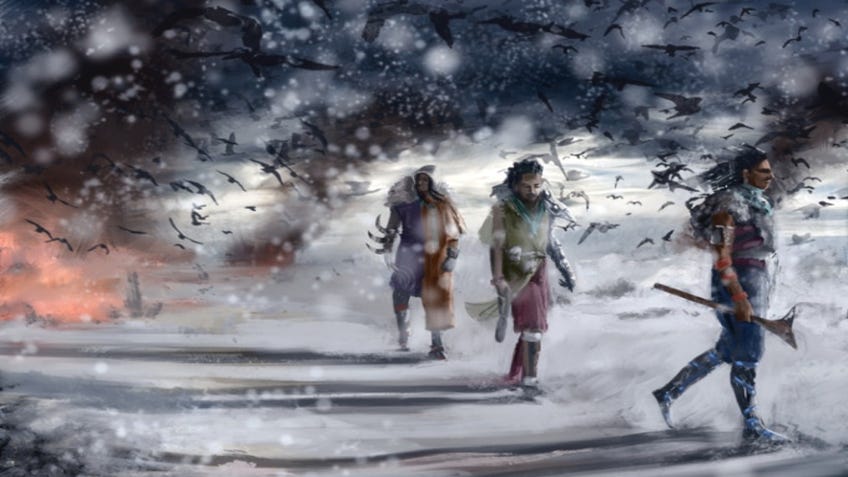RPG Coyote and Crow’s indigenous-led design team has created a tabletop world beyond the colonised mindset
“If a GM only gives their players nails, they're all going to equip themselves with hammers.”
Explore a world reborn from complete ecological collapse and set in a science-fantasy North America never touched by European colonialism in Coyote and Crow, an upcoming tabletop RPG from a team created and led by Native Americans.
The game is set 700 years after a climate disaster called the Awis nearly wiped humanity from the face of the planet. Makasing - what we call North America - has recovered enough that civilisations composed of its indigenous tribes can once again plan beyond the next frigid, ash-covered month. Bolstered by technology developed in humanity’s most desperate hour, these flourishing nations discover a new magic referred to as the Adahnehdi changing people, animals and the land itself.
The system is the brainchild of Cherokee designer Connor Alexander, who had been mulling over ideas of representation through colonial lenses in the tabletop space since 2018. “I started thinking about games that I like, worlds I want to play in, and I began trying to figure out how to create a world that put Indigenous cultures in the spotlight but disentangled it from colonialism,” he told Dicebreaker.
Alexander reached out to other indigenous artists, designers and creators even as he iterated on Coyote and Crow. Gradually, the team expanded to bring on writers such as Derek Pounds who said it was a support structure he didn’t realise he needed. “As a Native you're often put into the position of having to choose between repping for your community, or keeping your relationships healthy,” the Samish designer said in an email. “With an all Native team though, for me that hasn't happened. We have a lot of different perspectives, and as a team we've had disagreements, but we have that common core that lets us feel heard.”

Alexander was quick to qualify this success to being an established figure in board games - he runs consultancy and collaboration joint Sub-Level 3 - and said the talent on his team was simply waiting for someone to notice what they could accomplish when brought together.
“The core team I've worked to gather are fantastic people who I am proud to call my friends. We're from a variety of backgrounds and all have radically different histories, but I think one of the core ties that bind us is wanting to see those backgrounds represented more in our media,” Alexander said.
Coyote and Crow uses a d12 dice pool system partially inspired by collective decades spent playing World of Darkness games, alongside a desire to create a newcomer-friendly mechanical foundation that still provided something interesting for tabletop veterans. Both successes and failures rolled on ability or skill checks determine the outcome of an intended action, as well as the degree of effect. The design team encourages non-violent solutions to problems by providing characters a roster of moves that apply as easily to conversations as they do to a skirmish.
Alexander understands how easily it can be to default to a weapon when everything in a player’s toolkit seems designed around the unavoidable spilling of blood. “So many great stories, Native and otherwise, don't end with someone standing over a dead body. There's a strong emphasis on social skills in the game, and supernatural abilities that aren't about causing damage but about learning information, communication or de-escalating a situation,” he said.
Pounds said the Three Path system was intentionally designed to provide Story Guides - Coyote and Crow’s version of the GM - tools for preparing at least two outcomes in any scenario that don’t rely on unsheathing swords and nocking arrows. Characters’ Adahnehdi powers further diversify their options, providing plenty of interesting decisions to move the fiction forward.
“Not to use the obvious analogy, but if a SG only gives their players nails, they're all going to equip themselves with hammers,” Alexander said.
One of the most apparent additions Coyote and Crow brings to the tabletop space, beyond its setting, is an emphasis on decolonising traditional assumptions about how RPG stories should play out. Alexander specifically pointed to themes of “ownership and accumulation” as pitfalls for retreading the same tired - and often limiting - narrative paths. Makasing’s cities have 3D printers that provide characters’ with all basic necessities, and gear costs on the sheet have been abstracted.
The hope is for players to focus on advancing the short and long-term goals that replace XP systems for advancing in level and gaining access to more complex abilities. “Coyote and Crow isn't a utopia. There are political struggles and a looming possibility of war in this game. But the focus is shifted to learning and understanding,” he said.

Pounds agreed, saying too many campaigns end up being either “a group of heroes treks from the civilised world into an unexplored wilderness where they fight savages and find unexplainable technologies or; a group of heroes comes to a community on the fringes of civilisation that is beset by evil savages bent on the destruction of this peaceful community”.
Coyote and Crow’s system and setting has been designed to emphasise different stories, and the team hopes that comes across to new players - Native or otherwise. “While our team has lofty goals and great visions, we're all still writing from a colonised history. This is our best attempt at stripping some of that away,” Alexander said.
The Kickstarter campaign for Coyote and Crow will run through April 1st and has already smashed its initial goal of $18,000 by raising $386,013 at the time of writing. A digital copy of the planned 300-page sourcebook can be secured for $20 (£15), while a hardcover edition runs $50 (£36). More information about the setting, character creation and stretch goals can be found on their campaign page.



